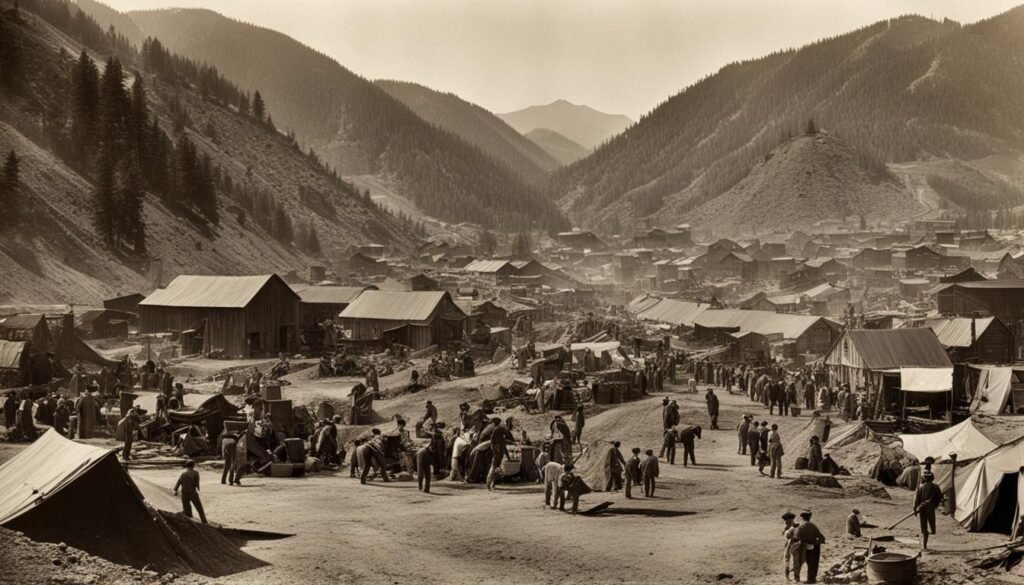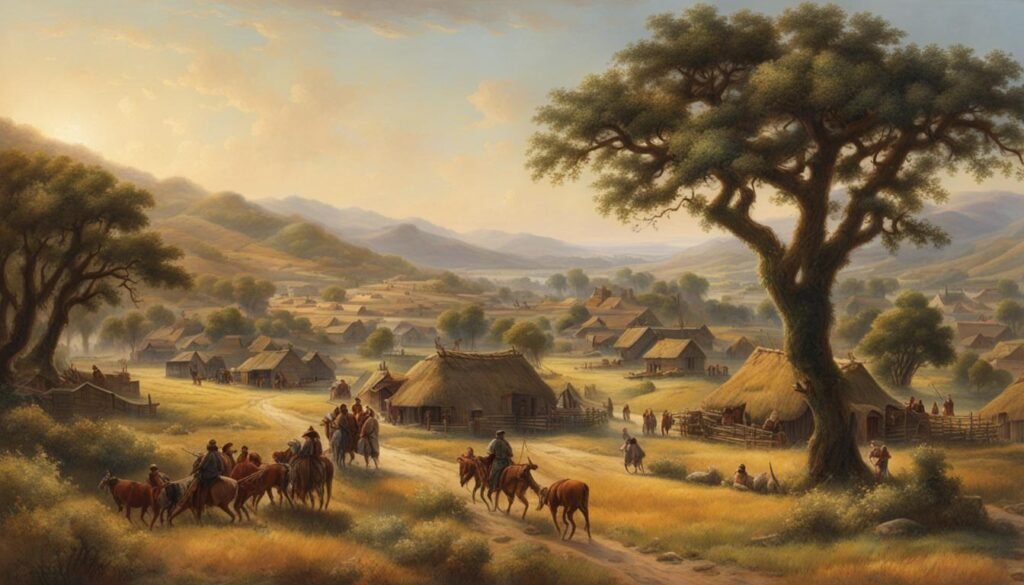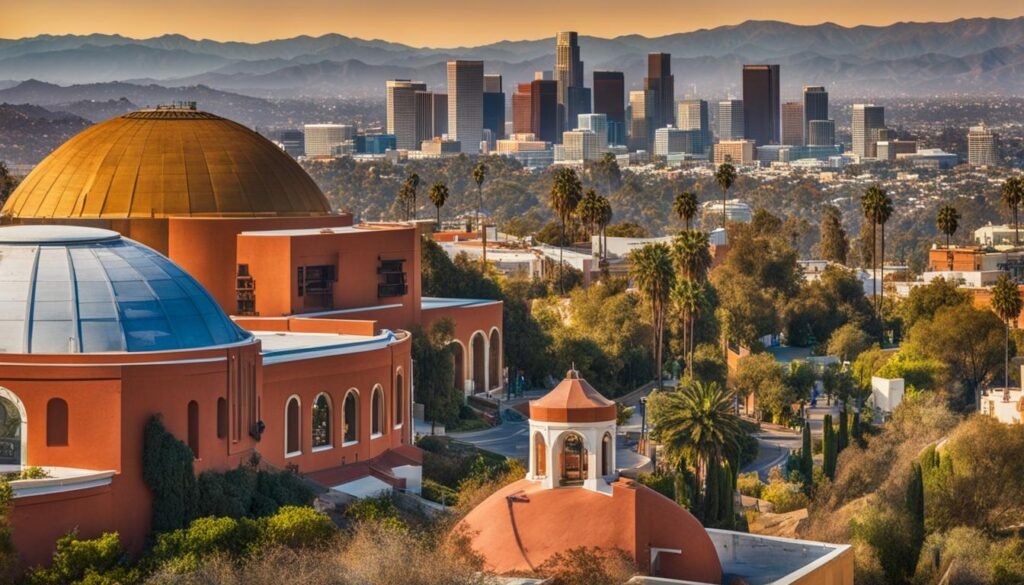Greetings! In this article, I’ll take you on a journey through the past to explore California in the year 1900. It was a time of significant growth and change for the Golden State. Let’s dive in and discover what life was like in California 100 years ago.
California’s population in 1900 was booming, attracting millions of new residents from all over the world. With its diverse economy consisting of specialty agriculture, oil, tourism, shipping, film, aerospace, and electronics, California was a land of opportunity and innovation.
But with this growth, California faced its own set of challenges. It’s intriguing to explore how California exported some of its worst problems to Texas and witness the impact of these migrations. This fascinating aspect of history sheds light on the interconnectedness of different states and the historical struggles they faced.
Key Takeaways:
- California experienced rapid growth and economic diversity in 1900.
- The state’s population saw a substantial increase, attracting immigrants from around the world.
- California faced challenges as it exported its worst problems to Texas, impacting both states.
- Specialty agriculture, oil, tourism, and the emerging film industry were key economic sectors.
- Technological advancements and innovations played a significant role in shaping California’s future.
Join me as we delve deeper into the historical events, demographic changes, notable landmarks, technological advancements, cultural diversity, and seismic impact that defined California in 1900. This exploration will provide valuable insights into the origins of California’s present-day identity and its enduring spirit of growth and resilience.
Historical Events in California 1900
In 1900, California witnessed several significant events that left a lasting impact on its history. These events played a crucial role in shaping the state’s development and showcasing its resilience.
The San Francisco Earthquake of 1906
One of the most notable historical events of the era was the devastating San Francisco earthquake of 1906. This earthquake, with a magnitude of 7.8, resulted in widespread destruction and loss of life. Buildings crumbled, fires engulfed the city, and thousands of people were displaced. The San Francisco earthquake is not only remembered for its devastating impact but also for the resilience and reconstruction efforts that followed, marking a turning point in California’s history.
The California Gold Rush
Another significant event in California’s history was the famous Gold Rush of the late 1800s. The discovery of gold in California attracted thousands of prospectors from all over the world, seeking fortune and a new life. This rush of people transformed California into a bustling hub of activity, sparking rapid growth and development. The California Gold Rush had a lasting impact on the state’s economy, infrastructure, and cultural identity, forever changing California’s landscape.
These historical events from 1900 serve as reminders of California’s resilience in the face of adversity and its ability to embrace change and progress. They are an integral part of the state’s rich history that continues to shape its present-day identity.
California’s Demographic Changes in 1900
The 1900 census data revealed a remarkable increase in California’s population during that time. Between 1900 and 1910, the state experienced a growth rate of over 60%. This surge can be attributed to the influx of immigrants from other states and countries who sought opportunities in California.
It took several decades for California to achieve a balanced male-to-female ratio. Not until the 1950 census did the state see an equal distribution of men and women. This demographic shift highlighted the evolving social dynamics and changing landscape of California in the 20th century.
Throughout the century, California’s population continued to grow steadily, reaching 37,253,956 by 2010. Such significant population growth reflected the appeal of California as a land of diverse opportunities, attracting people from all walks of life.
California’s Landmarks in 1900
In 1900, California boasted several remarkable landmarks that played a significant role in shaping the state’s identity. These landmarks showcased the natural beauty and cultural significance of the region. One such landmark was Yosemite National Park, established in 1890 and renowned for its breathtaking landscapes and picturesque valleys. Its towering granite cliffs, majestic waterfalls, and abundant wildlife made it a popular destination for nature-lovers and outdoor enthusiasts.
The state was also home to culturally significant landmarks, including the iconic Hollywood sign. Originally erected in 1903 as a billboard for a local real estate development, the sign quickly gained fame and became synonymous with the flourishing film industry centered in California. Over the years, it has become an enduring symbol of Hollywood glamour and cinematic excellence.
California’s economy in 1900 was thriving, driven by various industries. The state’s fertile land supported a robust agriculture sector, with crops such as citrus fruits, wine grapes, and avocados contributing to its prosperity. The mining industry, particularly the gold mines, played a pivotal role in California’s early years, attracting prospectors from all over the world in search of fortune. The abundance of natural resources, along with the state’s strategic coastal location, fueled a flourishing trade industry.
Technological Advancements in California 1900
During the early 1900s, California witnessed remarkable technological advancements that propelled the state to the forefront of innovation. This period marked a significant turning point in California’s history, particularly in the fields of aerospace and electronics. One notable outcome of this era was the emergence of Silicon Valley as a global center for computer technology and groundbreaking innovation.
Technological advancements played a pivotal role in shaping California’s economy and cementing its position as a worldwide leader in innovation. These advancements not only impacted the state’s industries but also influenced the lifestyles and aspirations of its residents.
California’s timeline in the early 1900s witnessed pioneering achievements that set the stage for future advancements. Some of the notable milestones include the establishment of the Stanford Research Institute (SRI International) in 1946, which contributed significantly to the development of modern computing and networking technologies. This establishment paved the way for groundbreaking research institutions and paved the path for transformative breakthroughs.
The early 1900s also saw California’s aerospace industry take off, with notable contributions from companies like Lockheed Martin and Northrop Grumman. These companies spearheaded the development of cutting-edge aircraft and propulsion systems, bolstering California’s reputation as a hub for aerospace innovation.
Innovation in Electronics
California’s technological prowess extended beyond aerospace and into the realm of electronics. Companies such as Hewlett-Packard (HP) and Fairchild Semiconductor played pivotal roles in revolutionizing the electronics industry.

HP, founded by William Hewlett and David Packard in 1939, became known for its groundbreaking advances in the design and production of electronic test and measurement equipment. Their innovative technologies set the foundation for modern electronics and have had a lasting impact on industries worldwide.
Fairchild Semiconductor, founded in 1957, was a key player in the development of integrated circuits, which are the building blocks of modern electronics. Their groundbreaking work laid the groundwork for the digital revolution, making California a hotbed for semiconductor innovation.
Continuing the Legacy: Silicon Valley
As technological advancements gathered momentum, Silicon Valley began to take shape during the mid-20th century. The region’s unique blend of top-tier universities, entrepreneurial spirit, and access to venture capital created the perfect environment for innovation to thrive.
The birth of Silicon Valley can be attributed to companies like Shockley Semiconductor Laboratory, founded by Nobel laureate William Shockley, and the subsequent establishment of companies like Fairchild Semiconductor and Intel. These pioneering companies attracted top talent and sparked a wave of innovation that continues to this day.
With companies like Apple, Google, and Tesla calling Silicon Valley home, the region has solidified its position as a global epicenter of technological advancements and entrepreneurship.
In conclusion, California’s technological advancements in the early 1900s propelled the state to new heights, making it a hotbed of innovation. From breakthroughs in aerospace to pioneering achievements in electronics, California’s contributions have had a profound impact on the world. Today, the legacy of technological excellence continues to shine through the vibrant ecosystem of Silicon Valley.
Cultural Diversity and Urbanization in California 1900
California in 1900 witnessed a remarkable growth in its population, leading to increased cultural diversity and urbanization. People from various backgrounds and ethnicities flocked to the state, weaving together a vibrant tapestry of cultures and traditions. Cities like Los Angeles, San Francisco, and San Diego experienced rapid urbanization, transforming from humble settlements into bustling metropolises.
The influx of diverse communities brought forth a unique blend of customs and lifestyles, shaping the California lifestyle in 1900. The streets of these cities were vibrant with a myriad of languages, cuisines, and celebrations, reflecting the rich cultural heritage of its inhabitants.
From Chinatown in San Francisco to Little Italy in Los Angeles, ethnic neighborhoods flourished, preserving and celebrating their distinct identities. California in 1900 was a melting pot, where cultures intermingled, influenced one another, and ultimately contributed to the state’s cultural fabric.
- The California lifestyle in 1900 was greatly influenced by this cultural diversity, with various cultural festivals, ethnic markets, and traditional events becoming a vibrant part of everyday life.
- The arrival of diverse communities also brought their unique traditions and practices, enriching the state’s social and religious landscape. Places of worship, ranging from churches and synagogues to temples and mosques, dotted the urban centers.
- The cultural fusion extended beyond the cities, manifesting in the arts, literature, and music scene. California’s diverse population inspired creativity and innovation, contributing to the birth of new artistic movements and expressions.
This cultural diversity and urbanization, which took root in California in 1900, continues to shape the state’s identity and lifestyle today. It serves as a testament to the enduring legacy left by the pioneers and settlers who made California their home.
The Effects of Earthquakes in California 1900
California, known for its picturesque landscapes and sunny beaches, is also susceptible to earthquakes. Located along several fault lines, including the notorious San Andreas Fault, the state has experienced its fair share of seismic activity. These earthquakes have had significant effects on California, shaping its history and contributing to its preparedness for future events.
One of the most infamous earthquakes in California’s history occurred in 1906. The San Francisco earthquake, with a magnitude of 7.8, struck the city and its surrounding areas, resulting in widespread devastation and loss of life. The impact was felt from Oregon to Los Angeles, making it one of the most destructive earthquakes recorded in the United States.
California’s resilience in the face of earthquakes can be attributed to its history of seismic activity. The state has been hit by several significant earthquakes, each leaving a lasting impact. These seismic events have not only shaped California’s physical landscape but also influenced its infrastructure and emergency response systems.

Conclusion
California’s history in the 1900s was a period of dramatic growth and transformation. From the excitement of the Gold Rush to the seismic impact of earthquakes, the state’s history is marked by significant events and developments. California’s past provides us with valuable insights into the origins of its present-day identity and the factors that have shaped its rich history and vibrant culture.
The Gold Rush of the late 1800s brought thousands of people to California, seeking fortune and opportunity. This event shaped the state’s economy and set the stage for future growth. The discovery of gold not only spurred immigration but also led to the establishment of cities, towns, and infrastructures that still define California landscape today.
Technological advancements in the early 1900s further propelled California’s growth and innovation. From aerospace to electronics, the state became a hub of cutting-edge development. Silicon Valley emerged as a global center for technological innovation, attracting visionary entrepreneurs and paving the way for the digital revolution.
California’s resilience was tested by devastating earthquakes, such as the infamous 1906 San Francisco earthquake. These seismic events have had lasting impacts on the state’s infrastructure, preparedness, and pioneering efforts in earthquake research and safety measures. More than just a chapter in California’s history, earthquakes have shaped its resilience and commitment to protecting its residents.
FAQ
What was California like in 1900?
California in 1900 was undergoing significant changes and experiencing rapid growth. The state’s economy was diverse, with industries such as specialty agriculture, oil, tourism, shipping, film, aerospace, and electronics. The population of California saw a substantial increase, with 35 million new residents coming to the state between 1900 and 2010. Silicon Valley also emerged as a hub for technological innovation.
What were some important historical events in California in 1900?
Some important historical events in California in 1900 include the San Francisco earthquake of 1906, which resulted in widespread destruction and loss of life. The discovery of gold in the late 1800s also led to the famous California Gold Rush, attracting thousands of people from around the world to seek fortune in the state.
What was the population of California in 1900?
The 1900 census showed a significant increase in California’s population, with a growth rate of over 60% between 1900 and 1910. Immigrants from other states and countries flocked to California, contributing to its booming population. It took until the 1950 census for California to achieve a balanced male-to-female ratio. The state’s population growth continued throughout the 20th century, reaching 37,253,956 by 2010.
What were some notable landmarks in California in 1900?
Some notable landmarks in California in 1900 include Yosemite National Park, which was established in 1890 and is known for its breathtaking natural beauty. The state also had culturally significant landmarks such as the Hollywood sign, which became a symbol of the film industry centered in California. The state’s economy was flourishing, driven by industries such as agriculture, mining, and trade.
What were some technological advancements in California in 1900?
California saw significant technological advancements in the early 1900s. The state became a center for innovation, especially in the fields of aerospace and electronics. It was during this time that Silicon Valley emerged as a global hub for computer technology and innovation. These technological advancements played a crucial role in shaping California’s economy and solidifying its position as a leader in innovation.
How did California’s population change in 1900?
California’s population growth in 1900 brought about increased cultural diversity and urbanization. People from various backgrounds and ethnicities settled in the state, creating a rich tapestry of cultures. Cities like Los Angeles, San Francisco, and San Diego experienced rapid urbanization, transforming them into bustling metropolises. The lifestyle in California in 1900 was influenced by this cultural diversity, creating a unique blend of traditions and customs.
What were the effects of earthquakes in California in 1900?
California is prone to earthquakes due to its location along several fault lines, including the San Andreas Fault. In 1906, the infamous San Francisco earthquake struck, resulting in widespread devastation and loss of life. The earthquake had a magnitude of 7.8 and was felt from Oregon to Los Angeles. California’s history is marked by several other significant earthquakes, which have shaped the state’s resilience and preparedness for future seismic events.
What can we learn from California’s history in the 1900s?
California in 1900 was a state experiencing tremendous growth and change. From the Gold Rush to technological advancements, earthquakes, and cultural evolution, the state’s history during this period is rich and multifaceted. Understanding California’s past provides insight into the origins of its present-day identity and the factors that have shaped the state’s history and culture.







